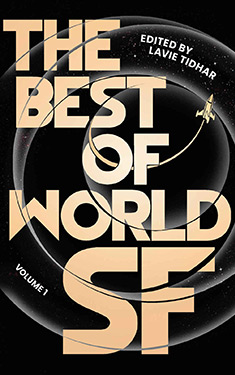
Added By: Administrator
Last Updated:
Sailing Bright Eternity
| Author: | Gregory Benford |
| Publisher: |
Bantam Spectra, 1995 |
| Series: | The Galactic Center Series: Book 6 |
|
1. In the Ocean of Night |
|
| Book Type: | Novel |
| Genre: | Science-Fiction |
| Sub-Genre Tags: | Human Development Artificial Intelligence Time Travel |
| Awards: | |
| Lists: | |
| Links: |
|
| Avg Member Rating: |
|
|
|
|
Synopsis
The slaughter has begun. The mechs -- violent artificial intelligences dedicated to the total destruction of the human race -- have ravaged humanity's planets throughout the galaxy, forcing the survivors to flee to the Esty, a strange space-time continuum constructed by ancient beings near the galaxy's True Center.
In the Esty, the battered human race makes its final stand against the relentless mechs. It soon becomes hideously clear that young warrior Toby Bishop, his father Killeen, and his grandfather have become special targets that the mechs' terrifying design involves their capture, torture, and extinction.
Excerpt
Metallovore
Black holes have weather, of a sort.
Light streams from them. Blackness dwells at their cores, but friction heats the infalling gas and dust. These streams brim with forced radiation. Storms worry them. White-hot tornadoes whirl and suck.
From the immense hole at the exact center of the galaxy, a virulent glow hammers outward. It pushes incessantly at the crowded masses that circle it, jostling in their doomed orbits. Gravity's gullet forces the streams into a disk, churning ever inward. Suffering in the weather.
The press of hot photons is a wind, driving all before it. Except for the grazers. To these photovores, the great grinding disk is a source of food.
Fire-flowers blossom in the disk, sending up lashes of fierce ultraviolet. Storms of light.
Both above and below the accretion disk, in hovering clouds, these photons smash molecules to atoms, strip atoms into bare charge, whip particles into sleet. The clouds are debris, dust, grains. They are already doomed by gravity's rub, like nearly everything here.
Nearly. To the gossamer, floating herds this is a fountain. Their life source.
Sheets of them hang, billowing with the electromagnetic winds. Basking in the sting. Holding steady.
The photovores are patiently grazing. Some are Infras, others Ultras-- tuned to soak up particular slices of the electromagnetic spectrum.
Each species has a characteristic polish and shape. Each works within evolutionary necessity, deploying great flat receptor planes. Each has a song, used to maintain orbit and angle.
Against the wrathful weather here, information is at least a partial defense. Position-keeping telemetry flits between the herd sheets. They sing luminously to each other in the eternal brimming day. Hovering on the pressure of light, great wings of high-gloss molysheet spread. Vectoring, skating on winds, magnetic torques in a complex dynamical sum. Ruling forces govern their perpetual, gliding dance. This is decreed by intelligences they scarcely sense, machines that prowl the darker lanes farther out.
Those magisterial forms need the energies from this furnace, yet do not venture here. The wise and valuable run no risks.
At times the herds fail. Vast shimmering sheets peel away. Many are cast into the shrouded masses of molecular clouds, which are themselves soon to boil away. Others follow a helpless descending gyre. Long before they could strike the brilliant disk, the hard glare dissolves their lattices. They burst open and flare with fatal energies.
Now a greater threat spirals lazily down. It descends from the shelter of thick, turbulent dust. It lets itself fall toward the governing mass, the black hole itself. Then it arrests its descent with outstretched wings of mirrors. They bank gracefully on the photon breeze.
Its lenses swivel to select prey. There a pack of photovores has clumped, disregarding ageless programming, or perhaps caught in a magetic flux tube. The cause does not matter. The predator eases down along the axis of the galaxy itself.
Here, navigation is simple. Far below, the rotational pole of the Eater of All Things is a pinprick of absolute black at the center of a slowly revolving, incandescent disk.
The clustered photovores sense a descending presence. Their vast sailing herds cleave, peeling back to reveal deeper planes of burnt-gold light seekers. They all live to ingest light and excrete microwave beams. Their internal world revolves around ingestion, considered digestion, and orderly excretion.
These placid conduits now flee. But those clumped near the axis have little angular momentum, and cannot pivot on a magnetic fulcrum. Dimly they sense their destiny. Their hissing microwaves waver.
Some plunge downward, hoping that the predator will not follow so close to the Eater. Others cluster ever more, as if numbers give safety. The opposite is true.
The metallovore folds its mirror wings. Now angular and swift, accelerating, it mashes a few of the herd on its carapace. It scoops them in with flux lines. Metal harvesters rip the photovores. Shreds rush down burnt black tunnels. Electrostatic fields separate elements and alloys.
Fusion fires await the ruined carcasses. There the separation can be exquisitely tuned, yielding pure ingots of any alloy desired. In the last analysis, the ultimate resources here are mass and light. The photovores lived for light, and now they end as mass.
The sleek metallovore never deigns to notice the layers of multitudes peeling back, their gigahertz cries of panic. They are plankton. It ingests them without registering their songs, their pain, their mortal fears.
Yet the metallovore, too, is part of an intricate balance. If it and its kind were lost, the community orbiting the Eater would decay to a less diverse state, one of monotonous simplicity, unable to adjust to the Eater's vagaries. Less energy would be harnessed, less mass recovered.
The metallovore prunes less efficient photovores. Its ancient codes, sharpened over time by natural selection, prefer the weak. Those who have slipped into unproductive orbits are easier to catch. It also prefers the savor of those who have allowed their receptor planes to tarnish with succulent trace elements, spewed up by the hot accretion disk below. The metallovore spots these by their mottled, dusky hue.
Each frying instant, millions of such small deaths shape the mechsphere.
Predators abound, and parasites. Here and there on the metallovore's polished skin are limpets and barnacles. These lumps of orange-brown and soiled yellow feed on chance debris from the prey. They can lick at the passing winds of matter and light. They purge the metallovore of unwanted elements--wreckage and dust that can jam even the most robust mechanisms, given time.
All this intricacy floats on the pressure of photons. Light is the fluid here, spilling up from the blistering storms far below in the great grinding disk. This rich harvest supports the mechsphere that stretches for hundreds of cubic light-years, its sectors and spans like armatures of an unimaginable city.
All this, centered on a core of black oblivion, the dark font of vast wealth.
Inside the rim of the garish disk, oblivious to the weather here, whirls a curious blotchy distortion in the fabric of space and time. It is called by some the Wedge, for the way it is jammed in so close. Others term it the Labyrinth.
It seems to be a small refraction in the howling virulence. Sitting on the very brink of annihilation, it advertises its artificial insolence.
Yet it lives on. The mote orbits perpetually beside the most awful natural abyss in the galaxy: the Eater of All Things.
Copyright © 1995 by Gregory Benford
Reviews
There are currently no reviews for this novel. Be the first to submit one! You must be logged in to submit a review in the BookTrackr section above.
Images
No alternate cover images currently exist for this novel.



















 Full Details
Full Details






